How to identify mildew on cannabis
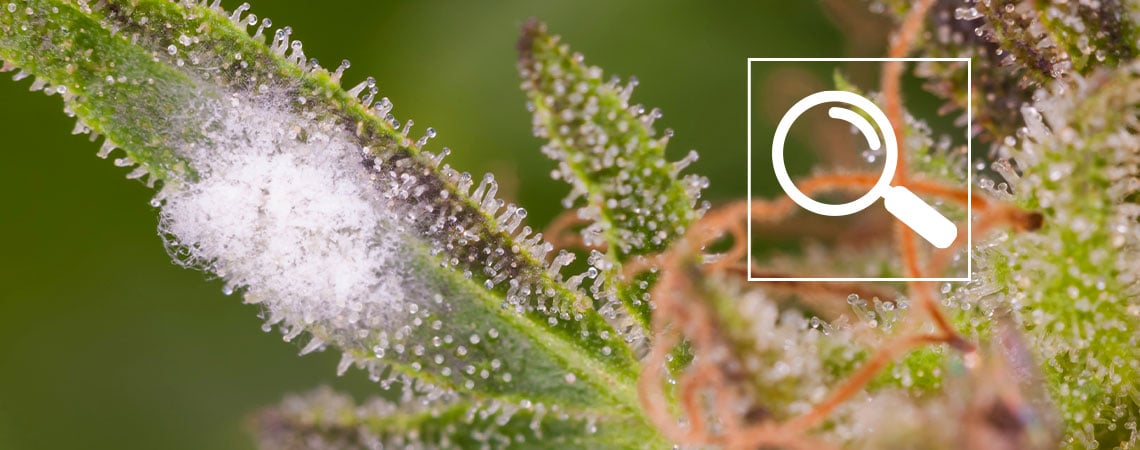
Powdery mildew is a common threat to cannabis plants, but it is also preventable. In this guide, you’ll learn how to identify early signs, take fast action, and protect your buds from further damage. Whether you're a first-time grower or a seasoned cultivator, find out more with Zamnesia.
Think your cannabis plant has mildew? Spotting it early could save your entire harvest. Powdery mildew on cannabis plants is one of the most common and frustrating problems growers can face, especially in small or indoor growing areas where airflow and humidity can quickly get out of balance. This sneaky fungus can seemingly appear out of nowhere, coating your leaves, stems, and even buds with a white, flour-like dust. But don't panic! The earlier you identify the signs, the easier it is to manage.
In this guide, we'll walk you through exactly what powdery mildew looks like, how to confirm it, what to do once you spot it, and how to keep it from coming back or appearing in the first place.
What is powdery mildew?

Powdery mildew is a fungal disease that commonly impacts cannabis plants, especially those in humid or poorly ventilated growing environments. It's caused by various species of fungi in the Erysiphales order, which produce a white or greyish coating on plant surfaces, most noticeably on the leaves. Unlike other pathogens that thrive in wet conditions, powdery mildew develops even on bone-dry leaf surfaces, making it particularly tricky for growers to predict and prevent.
What causes powdery mildew?
This fungus typically thrives under the following conditions:
- High humidity (above 60%)
- Poor air circulation
- Stale or stagnant air
- Crowded plant canopies
- Moderate temperatures (18–26°C or 65–78°F)
As you can see, there are many factors that can cause mildew. Even brief spikes in humidity or inconsistent airflow can be enough to trigger an outbreak, especially in indoor grow tents or greenhouses where microclimates form easily.
How does it spread?
Powdery mildew spreads via microscopic spores that are released into the air. These spores can land on nearby plants, tools, walls, or even your clothes, making them highly contagious and hard to contain once established. They require very little moisture to germinate, and can begin growing within 4–12 hours under ideal conditions.
Once the fungus has taken hold, it rapidly colonises, infecting leaves, stems, and eventually buds, weakening your plants and threatening the quality of your harvest. Left unchecked, it can spread to every plant in your grow space.
What does mildew look like on cannabis?
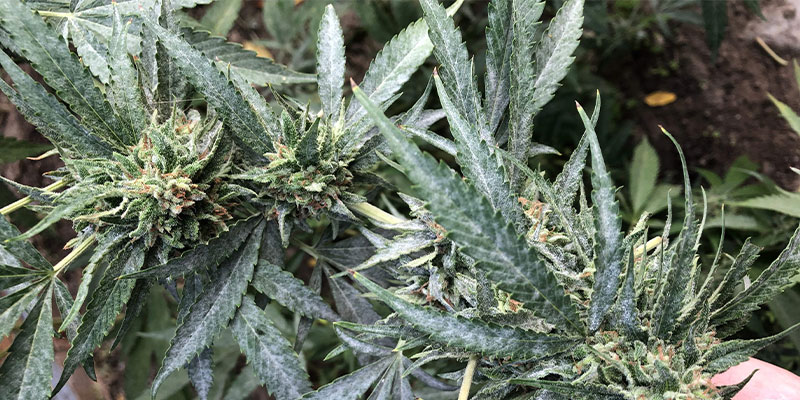
So, what are the signs of mildew? At a glance, powdery mildew on cannabis often first appears as tiny white spots on the upper surface of the leaves. These spots may look like dust, flour, or even trichomes to the untrained eye, but unlike natural resin, mildew spreads quickly and unevenly, creating a telltale patchy, powdery film.
Key visual cues of powdery mildew on marijuana plants
- White or greyish-white powder forming on leaf surfaces
- Random blotchy patterns
- Affected areas feel soft or fuzzy, unlike sticky trichomes
- Infection often starts on older or lower leaves before spreading upward
- Yellowing or distortion of the leaves as the fungus weakens the plant tissue
Commonly affected areas
- Leaves: This is where powdery mildew typically shows up first. Watch for dusty patches, especially near the edges or undersides.
- Stems: As the infection progresses, fuzzy white buildup may appear on stems and petioles.
- Buds: In more advanced cases, powdery mildew on bud can occur. This is especially dangerous, as it compromises the quality, safety, and smokability of your harvest.
Mildew may be easy to miss in its early stages, especially when confused with trichomes or nutrient-related white spotting. If you're unsure of what you're seeing, a small handheld magnifier can help you to differentiate between beneficial plant structures and harmful fungi.
For more information on diagnosing plant health problems beyond mildew, visit our dedicated guide to cannabis diseases.
Advanced symptoms and risks

If powdery mildew on weed is not detected early, it can quickly evolve from a minor leaf issue into a more serious infestation that can threaten the entire plant, especially your buds.
In more advanced stages, powdery mildew doesn't just stay on the leaves; it is capable of causing damage in a variety of other ways. Powdery mildew:
- Creeps onto sugar leaves and into buds, where it's harder to detect and remove.
- Forms a dense, web-like coating inside flower clusters, making it almost impossible to eradicate entirely.
- Can cause bud rot or pave the way for other fungal infections, particularly during flowering or drying.
Once mildew gets into your buds, you run the risk of losing large portions of your harvest. Even if you manage to salvage the flowers, their potency and flavours can be significantly compromised.
As powdery mildew progresses, it begins to interfere with the plant's ability to photosynthesise, resulting in stunted growth and weakening its overall vitality. Leaves may start to yellow, curl, or wilt, further reducing the energy production and leaving the plant much more vulnerable to pests and other diseases. If the infection reaches the buds, it can degrade the trichomes, completely diminishing the cannabinoid potency and terpene richness. Affected buds often take on a musty or mouldy smell, signalling that they're no longer safe to use.
Inhaling or consuming mildew-contaminated cannabis can be risky, particularly for those with respiratory conditions or weakened immune systems. What begins as a few harmless-looking white spots can quickly threaten the quality, health, and yield of your entire crop.
Differentiating powdery mildew from other issues
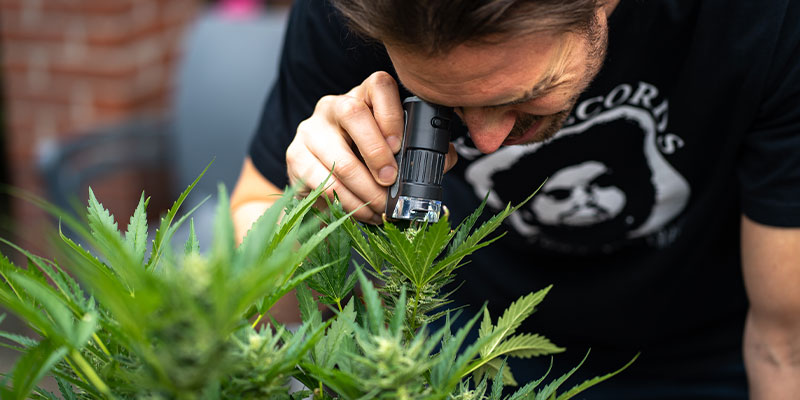
One of the trickiest parts of dealing with powdery mildew on cannabis is that its early symptoms can look deceptively similar to other harmless or unrelated conditions. White patches, for instance, may also be caused by trichomes, mineral residue, or nutrient imbalances, so it's essential to know the differences.
Powdery mildew vs trichomes
At first glance, powdery mildew can resemble a healthy layer of trichomes, the resinous, crystal-like glands that cover buds and leaves. But while trichomes sparkle and tend to form evenly over the plant, mildew has a dull, chalky, and blotchy appearance, often concentrated in random spots. Trichomes also feel sticky to the touch, while mildew has a dry, dusty texture.
Powdery mildew vs nutrient burn or residue
Nutrient burn may cause light patches or discolouration on leaves, but these usually have a brown or yellow tinge, especially towards the edges or tips. Mineral buildup from foliar sprays or hard water can also leave a powdery film, but it typically wipes off easily and won't spread to other plant parts.
As you might expect, correct identification is crucial. Treating the wrong problem can delay real solutions and give mildew time to spread. When in doubt, isolate the plant and inspect under proper lighting before action. As mentioned, you can always look to use a handheld magnifier to help get a closer look at any potential problems.
How to confirm powdery mildew
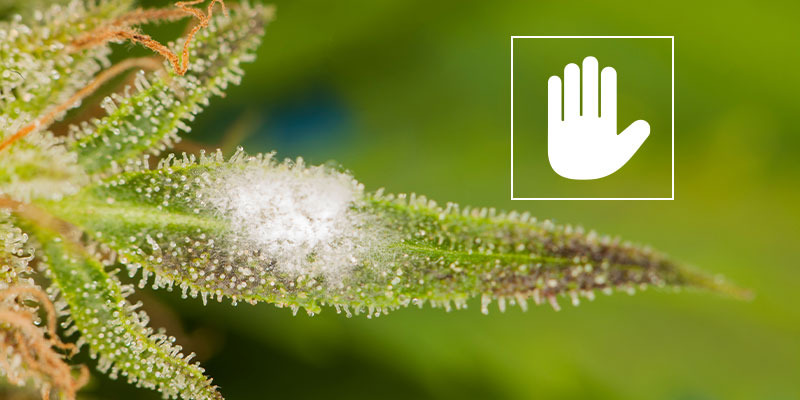
Before jumping into treatment, it's essential to be sure you're actually dealing with powdery mildew on cannabis, and not a harmless residue or another plant issue. With the right tools and a bit of close observation, you can confidently confirm an infection at home.
DIY methods to spot powdery mildew
Start with a simple wipe test:
- Gently rub a white spot on the leaf with your fingertip or a clean cotton swab.
- If the patch smears like dust or chalk, it's likely powdery mildew.
- If it stays intact or feels sticky, it may be trichomes or another non-fungal issue.
You can also look to mist the area lightly with water. Powdery mildew tends to absorb moisture and temporarily disappear, confirming its presence. This can help differentiate it from permanent leaf markings or mineral spots.
Recommended tools for better accuracy
To make diagnosis easier and more accurate, consider keeping the following tools in your grow kit:
- Handheld magnifier (30x or more): This helps you see the fuzzy, spore-like structure of mildew.
- LED flashlight: Use angled light to spot faint patches you might miss in overhead lighting.
- pH and humidity monitor: Mildew thrives in high humidity, so tracking conditions can help prevent recurrence.
When to seek expert advice
If you're still unsure after testing:
- Isolate the plant immediately to avoid potential spread.
- Take some high-quality photos in natural light and seek advice in online grower forums or local grow shops.
- When in doubt, taking preventative measures is safer than waiting for visible signs to worsen.
What to do if you spot powdery mildew on weed plants
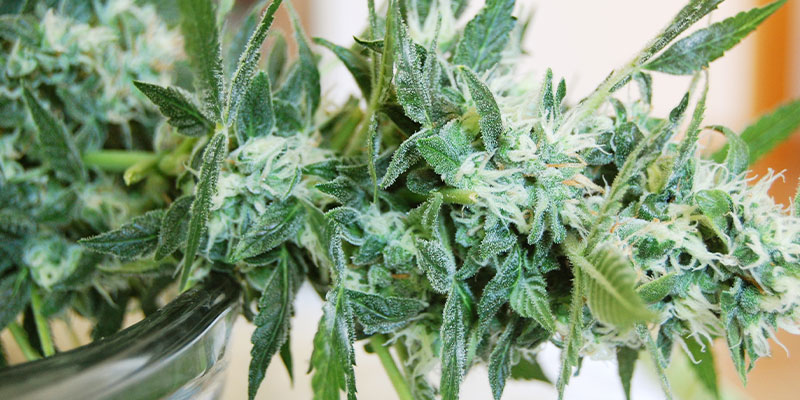
Catching powdery mildew on cannabis early gives you the best chance of saving your plants and protecting the rest of your grow. Here's a step-by-step guide to tackle the issue quickly and effectively.
1. Isolate the affected plants
The first step is damage control. Move any visibly infected plants away from healthy ones to prevent the spores from spreading through the air or via contact. If you're growing indoors, use separate tents or a sealed quarantine space if possible. Avoid brushing against infected plants while handling others, and always clean and disinfect your hands, gloves, and tools between uses.
2. Remove heavily affected leaves
Next, reduce the spore load:
- Trim off leaves that are heavily coated with mildew.
- Use sterilised scissors and place the removed material in a sealed bag. Never compost infected leaves, as spores can survive and reinfect future crops.
- Be gentle to avoid shaking spores into the air.
This step helps slow down the spread and makes room for effective treatments.
3. Apply immediate treatments
After isolating and trimming, treat the plant immediately to halt the infection:
- Use natural remedies like neem oil, potassium bicarbonate, or diluted hydrogen peroxide sprays. Always follow proper dilution guidelines to avoid stressing your plant.
- Apply treatments during the early light cycle and avoid direct sunlight to prevent leaf burn.
For ongoing prevention, consider picking out some companion plants like chives, which naturally deter mildew-causing fungi.
4. Wash buds if necessary
If mildew has spread to your buds and harvest time is near, consider washing your buds post-harvest. This can help remove spores and improve the safety and smokability of the flowers, though quality may still be affected.
These steps won't reverse the damage that's already been done, but they can contain the infection, save unaffected parts of your plant, and help you finish your grow cycle with minimal losses.
How to prevent powdery mildew
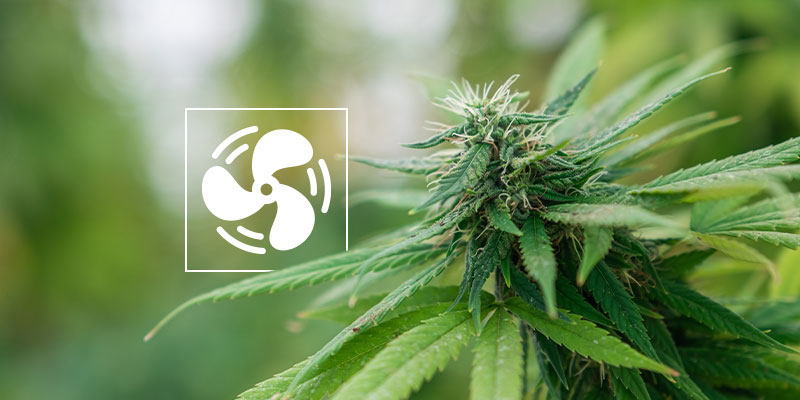
Like most cannabis plant ailments, while treatment is possible, prevention is always better, especially when it comes to powdery mildew. Once spores take hold, they can be stubborn and spread quickly. The good news? A few consistent good habits can drastically reduce your risk.
Here's how to curb powdery mildew on cannabis before it rears its head.
1. Improve air circulation in your grow space
Stale, humid air is a major trigger for mildew. Ensure your grow room or tent has plenty of airflow using oscillating fans and proper exhaust systems. Avoid overcrowding your plants; give them room to breathe and grow without leaves constantly brushing against each other.
2. Maintain ideal humidity levels
High humidity is one of the biggest culprits behind mildew outbreaks. During the vegetative phase, keep humidity between 40–70%, then drop it to 40–50% during the flowering stage. You can always use a hygrometer to monitor levels and consider a dehumidifier depending on your environment. Learn more about optimal humidity levels and find the perfect amount for the right stage of your growing project.
3. Use resistant strains
Some cannabis strains are naturally more resistant to mould and mildew, making them the perfect choice for growers in damp or tricky climates. Choosing a resistant variety from the get-go can save you a lot of trouble down the line. If you're short on ideas or unsure where to start, check out our list of the top 10 mould-resistant cannabis strains.
4. Sanitise grow equipment and environment
Always start each grow with a clean slate:
- Sterilise pots, trays, scissors, and tools.
- Wipe down walls and tent interiors with a diluted bleach or alcohol solution.
- Wash your hands or wear gloves when handling plants, especially if you've been outdoors or around other gardens.
Keeping things clean might sound like a basic premise, but it's often one of the most overlooked aspects of growing cannabis at home. However, it's also one of the most effective methods for preventing mildew.
Drying and storing post-infection
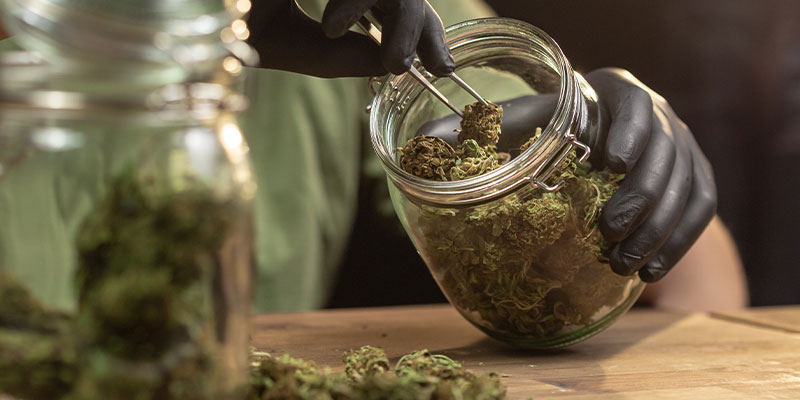
Even if you've experienced powdery mildew on weed plants, it's still possible to harvest usable bud if you dry and store it properly. The post-harvest phase is your last line of defence against mildew spreading further or developing into mould.
Safe drying methods after mildew
If mildew has reached your flowers, learn to spot the early stages of powdery mildew on dried buds, and be extra cautious during drying. Consider the following:
- Trim away any visibly infected sugar leaves before hanging or drying.
- Wash your buds post-harvest if contamination was mild. This won't save badly infected flowers, but it can remove lingering spores from lightly affected ones.
- Dry in a well-ventilated, low-humidity room (around 45–50%) with good air exchange.
- Hang buds loosely spaced apart. Avoid crowding or closed jars during this phase.
Remember, patience is key. A slow, steady dry (7–14 days) helps prevent mildew regrowth and preserves bud quality. For further information on how to properly dry and cure cannabis buds, take a look at our handy articles.
Proper storage to prevent future issues
Once the buds are dry:
- Cure them in glass jars with humidity packs to regulate moisture.
- Open the jars daily for the first week (“burping”) to release trapped humidity.
- Store in a cool, dark, and dry location. Avoid high temperatures and light exposure.
If you've dealt with mildew once, staying vigilant during storage is vital. If the conditions are right, a little residual moisture can easily restart fungal activity. There are many methods for preventing mould when storing cannabis, so it's easy to find one that suits your preference.
Powdery mildew on cannabis: Is it safe?
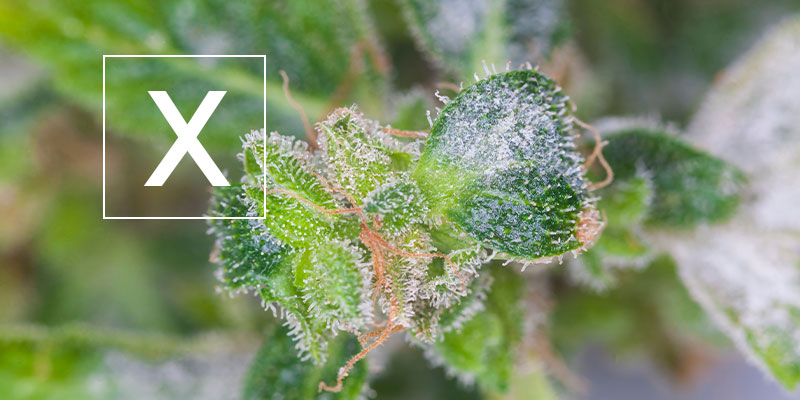
Cannabis affected by powdery mildew, especially when the buds are involved, is not safe to consume. Even small amounts of powdery mildew on dried buds can lead to respiratory irritation or more serious health concerns, particularly for sensitive users.
Again, watch out for those telltale signs like white, powdery spots on leaves, dust-like patches that smear when touched, and mildew spreading to buds, often accompanied by a musty smell and a visible loss of trichomes. As the infection worsens, you may also notice yellowing, curling leaves and overall stunted growth.
The good news? With early detection, prompt treatment, and simple preventative habits, you can contain the problem and protect your harvest. And if powdery mildew got the better of this grow, don't be discouraged; it's a common issue, and each cycle is a chance to improve. Start fresh with more resilient genetics that are better equipped to resist mould and mildew. You can browse cannabis seeds for your next grow and take the next step towards a healthier, mildew-free crop, armed with the knowledge and experience to make it your best harvest yet.





 United States
United States











